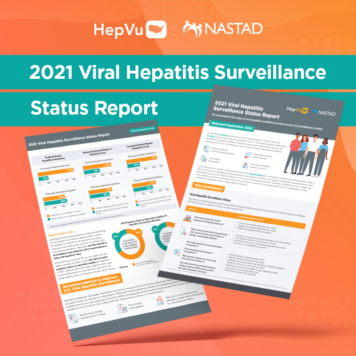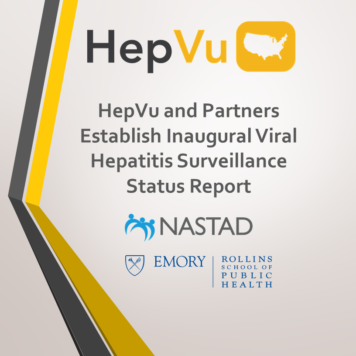This month, HepVu and NASTAD released the inaugural viral hepatitis surveillance status report to assess how jurisdictions across the U.S. are measuring the impact of viral hepatitis on their communities, identify best practices, and highlight areas in need of additional resources.
Heather Bradley, PhD, is an Associate Professor of Epidemiology at the Rollins School of Public Health at Emory University and serves as HepVu Project Director. Boatemaa Ntiri-Reid, JD, MPH is the Senior Director of Syndemic Approaches at NASTAD. In this role, she leads integration of HIV, viral hepatitis, and drug user health into a united framework for improving outcomes across these intersecting issues.
This report is the first of its kind for the viral hepatitis community. What was the impetus for the report and who will find the insights helpful?
Heather: At HepVu, one of our goals is to showcase state and local data on the burden of viral hepatitis, and how that burden of disease is different by geography and demographic characteristics so we can help policy makers understand where prevention and treatment resources are needed. One of the challenges is that because of resource limitations, we don’t have the completeness or the quality of viral hepatitis surveillance data necessary to illustrate burden of disease and, ultimately, to support elimination efforts. So, in the spirit of trying to support efforts to improve viral hepatitis surveillance capacity, we partnered with NASTAD to establish a baseline snapshot of where we are right now with viral hepatitis surveillance. We hope that the information presented in this baseline report will help lead to the bolstering of viral hepatitis surveillance with additional resources.
Boatemaa: I completely agree with Heather. To speak a little bit more about how critical it was to have that baseline information: in 2021, when the new cooperative agreement with the Centers for Disease Control and Prevention (CDC) went through, there were only 14 jurisdictions receiving viral hepatitis surveillance funding from CDC. The new cooperative agreement expanded funding to 59 jurisdictions. It was an opportune time for us through our partnership to determine what programs looked like at baseline providing a benchmark to measure their progress and the need for additional resources in the years to come. This report, and the substantial contributions of the jurisdictions to the report, is our opportunity to collect and document that information and make it publicly available.
What inspired collaboration between HepVu and NASTAD on this work? Why was the involvement of the steering committee deemed vital to the report’s success?
Heather: NASTAD provides critical, on the ground technical support to states and local jurisdictions for viral hepatitis surveillance, so the importance of our partnership with them on this work can’t be overstated. From the beginning, they really understood the vision for this surveillance report and why it was necessary. They were a key partner in all activities – framing the project, encouraging jurisdictions to respond, and summarizing findings. The steering committee also provided critical support. It was made up of folks in local health jurisdictions, leading national advocacy organizations, and clinical providers. Our partnership with NASTAD and the perspectives from the steering committee really helped us ensure this was not just an academic report, but something that was going to be useful to a variety of audiences, including those working on the ground to eliminate viral hepatitis.
Boatemaa: Even prior to joining NASTAD in 2018, HepVu and NASTAD were looking for opportunities for collaboration that would be truly meaningful and impactful. When this opportunity arose, we knew it was a great chance for a partnership. As Heather touched on, it was important for us to remember that while we are two partners who are highly dedicated to our work, we are a part of a vast community. Being able to engage the wide range of perspectives that exist within this community was absolutely critical to the support of this activity.
What does a more robust viral hepatitis surveillance system look like and what would it allow public health professionals and viral hepatitis intervention and programming to do to maximize impact?
Boatemaa: It would be easy to say that we are under resourced and don’t have the tools that we need, but that raises the question of what resources need to be put in. There is a fair level of debate about the core components we need in order to have a robust viral hepatitis surveillance system. What I don’t think is debatable is that we need to have national systems of viral hepatitis surveillance that allow us to collect case information across hepatitides. We need to have the capacity to then analyze the data that we collect at the local, state, and national levels, and our data need to be complete. Most importantly, we need to use that data to not only monitor the burden of disease, but also to prevent new cases and proactively move individuals living with viral hepatitis through the cascade to treatment and cure. The CDC has made integral contributions that have allowed us to get on the right path, but we really need to see investments from Congress in order to have an established infrastructure for viral hepatitis surveillance.
Heather: Very well said. As a surveillance epidemiologist, I view the core function of surveillance as understanding the burden of disease by person, time, and place. To do that, we have to be collecting, analyzing, and disseminating data in the same way across jurisdictions. This systematic collection of data allows us to identify areas with the highest burden of disease, new increases in burden of disease, and what kinds of people are most heavily impacted. For example, it is important to ensure we have complete data on race and ethnicity attached to our reports so we can understand racial disparities, particularly in hepatitis C. However, due to a lack of resources in viral hepatitis surveillance, we are not able to consistently perform these most basic core functions of surveillance in all parts of the country. Looking to the future, we also need to be able to track more sophisticated indicators, such as need for treatment and successful treatment outcomes. This is the type of information that will allow us to monitor progress toward elimination.
The report’s findings on 2021 U.S. viral hepatitis surveillance efforts are categorized into capacity, elimination goals, data dissemination, dedicated staffing, and pregnancy data: all of which speak to varying levels of jurisdiction funding and resources. What insights did you find surprising and stand out for elimination strategies moving forward?
Boatemaa: First and foremost, I was overwhelmed by the response that we received. We know our public health infrastructure and workforce has been overwhelmed with COVID, the ongoing viral hepatitis epidemic, and MPV. Out of the 59 jurisdictions funded by the CDC for viral hepatitis surveillance, we received 56 responses. It is no surprise that the phenomenal people in this field would make time for this, but the quality and quantity of responses we received in such a short period was astonishing.
I was also really excited by the amount of work that has been happening despite the current limited levels of funding and resources. Fifteen of the jurisdictions have published viral hepatitis strategic plans and elimination plans without any discrete funding for that purpose, and 24 jurisdictions have established elimination goals. There is also significant amount of work underway to conduct investigations for acute hepatitis B and C.
Additionally, in conducting this work, we made sure to pay attention to the challenges that impede the collection of accurate and timely viral hepatitis surveillance. In addition to a lack of funding, we also identified a related lack of staffing, data matching, and reporting of hepatitis C among pregnant individuals. If it weren’t for the robust survey responses, we wouldn’t have this rich information to build upon as we work towards strengthening our viral hepatitis surveillance systems.
Heather: Another finding that was not necessarily surprising, but certainly validating, was that the jurisdictions who had funding prior to 2021—or who had at least one full-time staff member working on surveillance—were able to perform more advanced core surveillance functions. This finding makes sense, but it really highlights the difference funding makes. Oftentimes we talk about limitations, and how viral hepatitis surveillance systems are broken, but the truth is they are just under-resourced. When the resources are there, we do see higher capacity for more robust surveillance activities, which we should consider a sign of hope.
What do we need to do as a nation, and at the local level, to take the biggest strides in reaching our viral hepatitis elimination goals?
Heather: I do a lot of work relating to the health of people who inject drugs, and this is the population in which there are the most new hepatitis B and C infections. In order to manage this increased risk for new infections, we need to be prioritizing vaccination, testing, and treatment for people who inject drugs, including removing treatment restrictions and improving access to harm reduction. As a country, we must start allocating more resources toward providing this population with the services that they need. We would also be remiss if we didn’t mention that without more robust viral hepatitis surveillance systems, we won’t know if we have reached our viral hepatitis elimination goals.
Boatemaa: I completely agree with Heather, particularly on the point of prioritizing by population and recognizing intersections. At the core of this issue is health equity. Even if we were to get the hundreds of thousands or millions of dollars we would need to eliminate viral hepatitis, we would still have to establish priorities in order to get the work done. A key part of establishing those priorities is identifying the populations that are most impacted and implementing the core elimination activities within those populations first and foremost. We really do have to prioritize this approach, and we will be successful if we do.
Given the results of this study, what does this report signify for the future of viral hepatitis surveillance?
Boatemaa: We have a lot of work to do, but we have the right people in place to get it done. We have a dedicated and brilliant workforce already in place, but they are being overworked and don’t have the resources that they need to make significant progress. At this time, the most pressing challenge is to increase funding and staffing to address burnout among an already overworked surveillance workforce, but one that has ample opportunity for growth. We need to dedicate ourselves, as a nation, to the reality that we can eliminate viral hepatitis. This goal needs to be not just something we are simply wishing for, but that we are actively making happen.
Heather: I completely agree. Over the course of this work, I have become more hopeful about the future of viral hepatitis surveillance. As Boatemaa said, we have seen amazing work from jurisdictions with such limited resources. This gives us hope that with more resources we could actually reach our goals. It has also been exciting to foster such meaningful partnerships with NASTAD, CDC, and the folks that make up our steering committee. I find it really hopeful that so many organizations at the non-governmental organization (NGO), federal, state, local, and advocacy levels came together to put their thoughts, energy, and time into getting this work done. If we maintain this commitment among so many smart, energetic people with the right resources there is nothing that we cannot do.


